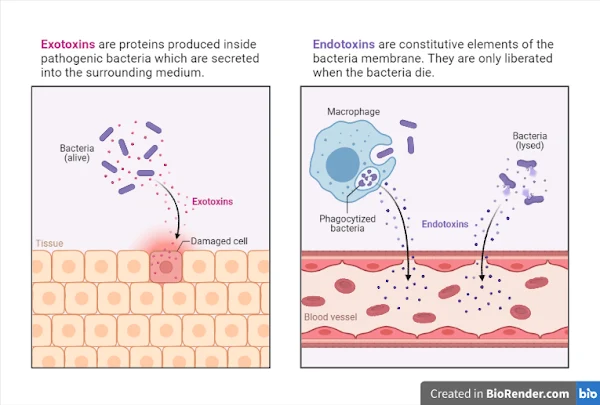Exotoxins:
- Exotoxins are proteins secreted by bacteria into the surrounding environment.
- They are typically produced by both Gram-positive and Gram-negative bacteria.
- Exotoxins can target specific cell types and have various mechanisms of action, including enzymatic activity, cell membrane disruption, and interference with intracellular signaling pathways.
- Examples of exotoxins include:
- Diphtheria toxin produced by Corynebacterium diphtheriae
- Botulinum toxin produced by Clostridium botulinum
- Tetanus toxin produced by Clostridium tetani
- Cholera toxin produced by Vibrio cholerae
- Pertussis toxin produced by Bordetella pertussis
- Endotoxins:
- Endotoxins are lipopolysaccharides (LPS) found in the outer membrane of Gram-negative bacteria.
- They are released when the bacterial cell is lysed or undergoes cell division.
- Endotoxins can trigger a strong immune response in the host, leading to inflammation, fever, and septic shock.
- The most well-known endotoxin is lipopolysaccharide (LPS), which is found in the outer membrane of Gram-negative bacteria such as Escherichia coli, Salmonella spp., and Pseudomonas aeruginosa.
Enterotoxins:
- Enterotoxins are exotoxins that target the intestines, causing diarrhea and vomiting.
- They are produced by various bacteria, including Staphylococcus aureus and enterotoxigenic strains of Escherichia coli.
- Enterotoxins can disrupt the normal function of intestinal cells and lead to fluid loss and electrolyte imbalance.
Cytotoxins:
- Cytotoxins are toxins that cause damage to host cells by inducing cell death or interfering with cellular processes.
- They are produced by a variety of pathogenic bacteria, including Clostridium difficile, which produces toxins A and B that damage the intestinal epithelium.
Hemolysins:
- Hemolysins are toxins that lyse red blood cells (hemolysis).
- They are produced by various bacteria, including Streptococcus pyogenes, which produces streptolysins that contribute to the pathogenesis of diseases such as streptococcal pharyngitis and necrotizing fasciitis.
These are just a few examples of the toxins produced by bacteria. Bacterial toxins play crucial roles in the pathogenesis of infectious diseases and can have significant implications for diagnosis, treatment, and prevention.
Toxins produced by bacteria falls into two primary groups viz. exotoxin and endotoxin. The characteristics of these group of toxins are given in Table 1.
Table 1 Toxins produced by bacteria
| Exotoxins | Endotoxins |
|---|---|
| Excreted by living cells. | Released in bacterial death and in part during growth. |
| Produced by both Gram-positive and Gram-negative bacteria. | Limited only to Gram-negative bacteria. |
| Relatively unstable and toxicity often destroyed rapidly on heating at temperature above 60o. | Relatively stable and withstand heating at temperature above 60o for hours without loss of toxicity. |
| Highly antigenic. | Weakly immunogenic. |
| Highly toxic even in microgram quantities or less. | Moderately toxic and range comprises from tens to hundreds of micrograms. |
| Binds to specific receptors on cells. | Specific receptors are not found in cells. |
| Not pyrogenic. | Pyrogenic and usually induce fever in the host by release of interleukin-1 and other mediators. |
| Controlled by plasmids. | Synthesis directed by chromosomal genes. |
| Examples: Tetanus Toxins/Tetanospasmin; Diphtheria Toxin; Botulinum Toxin; Toxix shock syndrome toxin-1 (TSST-1) and alpha toxin of Clostridium perfringens | Examples: LPS of Gram-negative bacteria |
References
| 1 | Jawetz, Melnick, & Adelberg's Medical Microbiology, 27th Edition Copyright © 2016 by McGraw-Hill Education. |

No comments:
Post a Comment